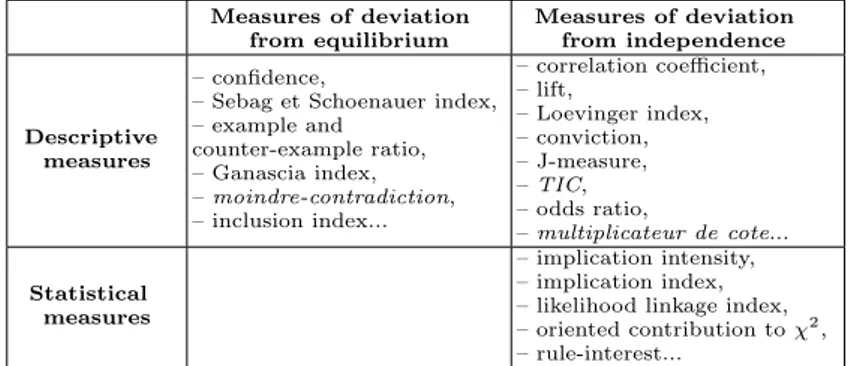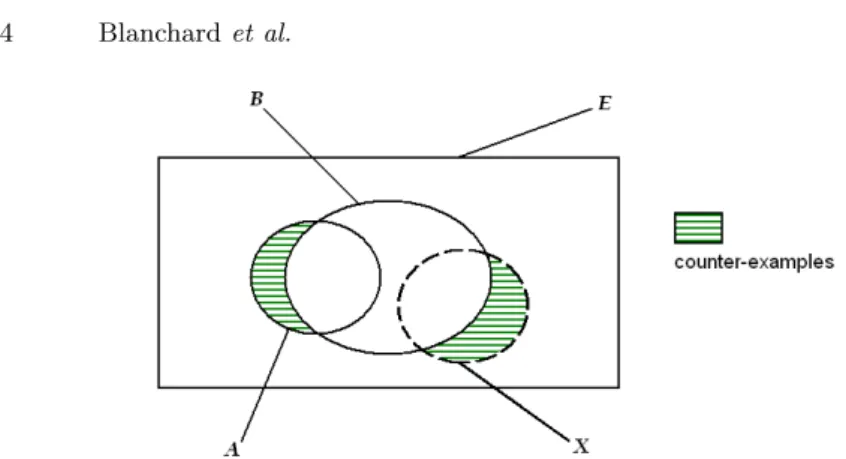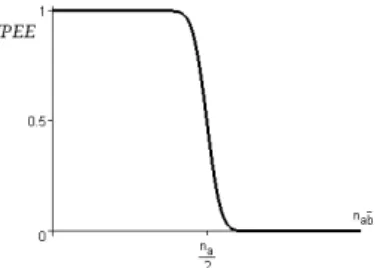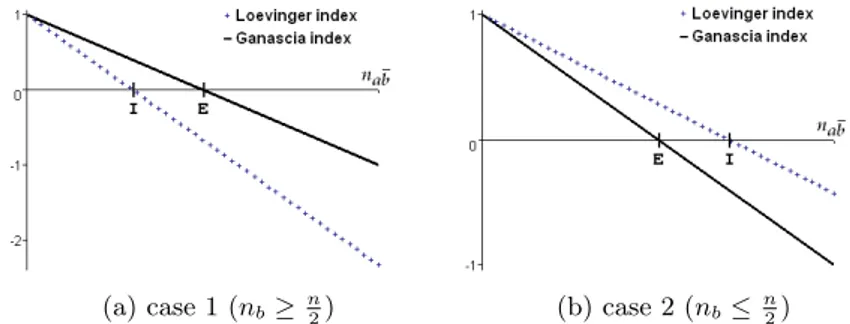HAL Id: hal-00420982
https://hal.archives-ouvertes.fr/hal-00420982
Submitted on 30 Sep 2009
HAL is a multi-disciplinary open access
archive for the deposit and dissemination of
sci-entific research documents, whether they are
pub-lished or not. The documents may come from
teaching and research institutions in France or
abroad, or from public or private research centers.
L’archive ouverte pluridisciplinaire HAL, est
destinée au dépôt et à la diffusion de documents
scientifiques de niveau recherche, publiés ou non,
émanant des établissements d’enseignement et de
recherche français ou étrangers, des laboratoires
publics ou privés.
measure of deviation from equilibrium
Julien Blanchard, Fabrice Guillet, Henri Briand, Régis Gras
To cite this version:
Julien Blanchard, Fabrice Guillet, Henri Briand, Régis Gras. Assessing rule interestingness with
a probabilistic measure of deviation from equilibrium. 11th international symposium on Applied
Stochastic Models and Data Analysis ASMDA 2005, 2005, France. pp.191-200. �hal-00420982�
Assessing rule interestingness with
a probabilistic measure of
deviation from equilibrium
Julien Blanchard, Fabrice Guillet, Henri Briand, and Régis Gras
LINA – FRE 2729 CNRS Polytech’Nantes
La Chantrerie – BP 50609 44306 – Nantes cedex 3 – France julien.blanchard@polytech.univ-nantes.fr
Abstract. Assessing rule interestingness is the cornerstone of successful applica-tions of association rule discovery. In this article, we present a new measure of interestingness named IP EE. It has the unique feature of combining the two fol-lowing characteristics: first, it is based on a probabilistic model, and secondly, it measures the deviation from what we call equilibrium (maximum uncertainty of the consequent given that the antecedent is true). We study the properties of this new index and show in which cases it is more useful than a measure of deviation from independence.
Keywords: Data mining, Association rules, Interestingness measures, Statistical significance, Deviation from equilibrium.
1
Introduction
Among the knowledge models used in Knowledge Discovery in Databases (KDD), association rules [Agrawal et al., 1993] have become a major concept and have received significant research attention. Association rules are impli-cative tendencies a → b where a and b are conjunctions of items (boolean variables of the form databaseAttribute = value). Such a rule means that if a record verifies the antecedent a in the database then it certainly verifies the consequent b.
A crucial step in association rule discovery is post-processing, i.e. the in-terpretation, evaluation, and validation of the rules in order to find interesting knowledge for decision-making. Indeed, due to their unsupervised nature, the data mining algorithms can produce a great many rules, many of which have no interest. To help the user (a decision-maker specialized in the data stu-died) to find relevant knowledge in this mass of information, one of the main solutions consists in evaluating and sorting the rules with interestingness mea-sures. There are two kinds of measures: the subjective (user-oriented) ones and the objective (data-oriented) ones. Subjective measures take into account the user’s goals and user’s a priori knowledge of the data [Liu et al., 2000] [Padmanabhan and Tuzhilin, 1999] [Silberschatz and Tuzhilin, 1996]. On
the other hand, only the data cardinalities appear in the calculation of objec-tive measures [Tan et al., 2004] [Bayardo and Agrawal, 1999] [Guillet, 2004] [Lenca et al., 2004] [Lallich and Teytaud, 2004]. In this article, we are inter-ested in the objective measures.
We have shown in [Blanchard et al., 2004] that there exist two different but complementary aspects of the rule interestingness: the deviation from independence and the deviation from what we call equilibrium (maximum uncertainty of the consequent given that the antecedent is true). Thus, the objective measures of interestingness are divided into two groups:
• the measures of deviation from independence, which have a fixed value when the variables a and b are independent (n.nab= nanb)1;
• the measures of deviation from equilibrium, which have a fixed value when examples and counter-examples are equal in numbers (nab= nab= 12na).
The objective measures can also be classified according to their descriptive or statistical nature [Lallich and Teytaud, 2004] [Gras et al., 2004]:
• The descriptive (or frequential) measures are those which do not vary with the cardinality expansion (when all the data cardinalities are increased or decreased in equal proportion).
• The statistical measures are those which vary with the cardinality ex-pansion. Among them, one can find the probabilistic measures, which compare the observed distribution to an expected distribution, such as the implication intensity [Gras, 1996] [Blanchard et al., 2003b] or the li-kelihood linkage index [Lerman, 1991].
Measures of deviation from equilibrium Measures of deviation from independence Descriptive measures – confidence,
– Sebag et Schoenauer index, – example and counter-example ratio, – Ganascia index, – moindre-contradiction, – inclusion index... – correlation coefficient, – lift, – Loevinger index, – conviction, – J-measure, – TIC, – odds ratio, – multiplicateur de cote... Statistical measures – implication intensity, – implication index, – likelihood linkage index, – oriented contribution to χ2,
– rule-interest...
Table 1.Classification of the objective measures of rule interestingness
With these two criteria, we classify the objective measures of rule inter-estingness into four categories. As shown in table 1 (cf. [Guillet, 2004] for
IPEE: probabilistic index of deviation from equilibrium 3
the references), there are no statistical measures which evaluate the deviation from equilibrium. Nevertheless, the statistical measures have the advantage of taking into account the size of the phenomena studied. Indeed a rule is statistically all the more reliable since it is assessed on a large amount of data. Moreover, when based on a probabilistic model, a statistical measure refers to an intelligible scale of values (a scale of probabilities); this is not the case for many interestingness measures. Also, such a measure facilitates the choice of a threshold for filtering the rules, since the complement to 1 of the threshold has the meaning of the significance level of a hypothesis test (generally in a test, one chooses α ∈ {0.1%, 1%, 5%}).
In this article, we propose a new measure of rule interestingness which evaluates the deviation from equilibrium while having a statistical nature. More precisely, this index is based on a probabilistic model and measures the statistical significance of the deviation from equilibrium (whereas implication intensity or likelihood linkage index, for example, measure the statistical significance of the deviation from independence). In the next section, we present a probabilistic index of deviation from equilibrium named IPEE, and then study in section 3 its properties. Section 4 is devoted to the comparison between the measures of deviation from equilibrium and the measures of deviation from independence.
2
Measuring the statistical significance of the deviation
from equilibrium
We consider a set O of n objects described by boolean variables. In the association rule terminology, the objects are transactions stored in a database, the variables are called items, and the conjunctions of variables are called itemsets. Given an itemset a, we note A the set of the objects which verify a, and na the cardinality of A. The complement of A in O is the set A of
cardinality na. An association rule is a couple (a, b) noted a → b where a
and b are two itemsets which have no items in common. The rule examples are the objects which verify the antecedent a and the consequent b (objects in A ∩ B), while the rule counter-examples are the objects which verify a but not b (objects in A ∩ B). In the following, we call "variables" the itemsets.
2.1 Random model
Given a rule a → b, we want to measure the statistical significance of the rule deviation from equilibrium. As the equilibrium configuration is defined by the equidistribution in A of examples A ∩ B and counter-examples A ∩ B, the null hypothesis is the hypothesis H0of equiprobability between the examples
and counter-examples. So, let us associate to the set A a random set X of cardinality na drawn in O under this hypothesis: P(X ∩ B) = P(X ∩ B)
Fig. 1.Random draw of a set X under the equiprobability hypothesis between the examples and counter-examples
cardinality of X ∩ B, noted¯¯X ∩ B¯¯. It is a random variable whose nabis an observed value. The rule a → b is even better since there is a high probability that chance creates more counter-examples than data.
Définition 1 The probabilistic index of deviation from equilibrium (IPEE2) of a rule a → b is defined by:
IP EE(a → b) = P(¯¯X ∩ B¯¯ > nab | H0)
A rule a → b is said to be acceptable with the confidence level 1 − α if δ(a → b) ≥ 1 − α.
Therefore, IPEE quantifies the unlikelihood of the smallness of the num-ber of counter-examples nabwith respect to the hypothesis H0. In particular,
if δ(a → b) is close to 1 then it is unlikely that the features (a and b) and (a and b) are equiprobable. This new index can be seen as the complement to 1 of the p-value of a hypothesis test (and α as the significance level of this test). However, following the implication intensity and the likelihood linkage index (where H0is the hypothesis of independence between a and b), the aim
is not testing a hypothesis but actually using it as a reference to evaluate and sort the rules.
2.2 Analytical expression
In the case of drawing random sets with replacement, ¯¯X ∩ B¯¯ is binomial with parameters na and 12:
δ(a → b) = 1 − 1 2na nab X k=0 µ na k ¶
IPEE: probabilistic index of deviation from equilibrium 5
IPEE depends neither on nb (it does not increase with the rarity of the
consequent), nor on n since the equilibrium hypothesis H0 is not defined
by means of nb and n (contrary to the independence hypothesis). It must
be noticed that the statistical significance of the deviation from equilibrium could be measured by comparing not the counter-examples but the examples: I dP EE(a → b) = P(|X ∩ B| < nab | H0). However, since the binomial
distributions with parameter12 are symmetrical, the two indexes are identical:
IP EE(a → b) = 1− 1 2na na X K=nab µ na na− K ¶ = 1− 1 2na na X K=nab µ na K ¶ = I dP EE(a → b) where K = na− k.
When na ≥ 10, the binomial distribution can be approximated by the
normal distribution with mean na
2 and standard deviation
pna
4 . The
stan-dardized number of counter-examplesenabcan be interpreted as the oriented
contribution to the χ2of goodness-of-fit between the observed distribution of
examples/counter-examples, and the uniform distribution: χ2 =en ab
2
This constitutes a strong analogy with the implication intensity and the likelihood linkage index, since in the poissonian models of these two measures, the stan-dardized values of nab and nab can be seen as oriented contributions to the
χ2of independence between a and b [Lerman, 1991].
3
IPEE properties
Range [0; 1]
Value for logical rules 1 − 1 2na
Value for equilibrium 0.5 Variation w.r.t. nabwith fixed na &
Variation w.r.t. nawith fixed nab %
Table 2.IPEE properties
The properties and the graph of IPEE are given respectively in table 2 and figure 2. We can observe that :
• IPEE varies slightly with the first counter-examples (slow decrease). This behavior is intuitively satisfactory since a small number of counter-examples do not question a rule [Gras et al., 2004].
• The discarding of the rules gets quicker in an uncertainty range around the equilibrium nab= na
As shown in figure 3, with a ratio examples/counter-examples which is constant, the values of IPEE are all the more extreme (close to 0 or 1) since na is large. Indeed, owing to its statistical nature, the measure takes into
account the size of the phenomena studied: the larger na is, the more one
can trust the imbalance between examples and counter-examples observed in the data, and the more one can confirm the good or bad quality of the rule deviation from equilibrium. In particular, for IPEE, the quality of a logical rule (rule with no counter-examples, i.e. nab= 0) depends on na(cf. table 2).
Thus, contrary to the other measures of deviation from equilibrium (cf. table 1), IPEE has the advantage of systematically attributing the same value to the logical rules. This allows to differentiate and sort the logical rules.
Fig. 2.Plot of IPEE w.r.t. the number of counter-examples nab
It must be noticed that IPEE has no symmetry: it does not assign the same value to a rule a → b and to its converse b → a, or to its contrapositive b→ a, or to its opposite a → b. Nevertheless, we have the following relation: δ(a → b) = 1 − δ(a → b) −C
nab na
2na (the last term is negligible when nais large).
We have seen that the strength of statistical significance measures lies in the fact that they take into account the size of the phenomena studied. On the other hand, it is also their main limit: the measures have a low discriminating power when the size of the phenomena is large (beyond around 104) [Elder and Pregibon, 1996]. Indeed, with regard to large cardinalities,
even minor deviations can be statistically significant. IPEE does not depart from this: when na is large, the measure tends to evaluate the rules as either
very good (values close to 1), or very bad (values close to 0). In this case, to fine-tune the filtering of the best rules, it is necessary to use a descriptive measure (cf. table 1) such as the inclusion index [Blanchard et al., 2003b] in addition to IPEE. On the other hand, contrary to the implication intensity or the likelihood linkage index, IPEE does not depend on n. Therefore, the measure is sensitive to both the specific rules ("nuggets") and the general rules ; it can be used on either small or large databases.
IPEE: probabilistic index of deviation from equilibrium 7
Fig. 3.Plot of IPEE w.r.t. cardinality expansion (na= 20 × γ, nab∈ [0 × γ ; 20 × γ], γ ∈ {1; 5; 40; 1000})
4
Measures of deviation from equilibrium and
independence: a comparison
Let us consider a rule with the cardinalities nab, na, nb, n. By
va-rying nab with fixed na, nb, and n, one can distinguish two different cases
[Blanchard et al., 2004] : • If nb ≥ n2 (case 1), then
nanb
n ≤
na
2 , so the rule goes through the
inde-pendence before going through the equilibrium when nabincreases. • If nb ≤ n2 (case 2), then
nanb
n ≥
na
2 , so the rule goes through the
equili-brium before going through the independence when nabincreases. Let us now compare a measure of deviation from equilibrium Meql and a
measure of deviation from independence Midpfor these two cases. In order
to have a fair comparison, we suppose that the two measures have similar behaviors:
• same value for a logical rule,
• same value for equilibrium/independence,
• same decrease speed with regard to the counter-examples.
For example, Meql and Midp can be the Ganascia and Loevinger indexes
[Ganascia, 1991] [Loevinger, 1947] (cf. the definitions in table 3), or IPEE and the implication intensity. As shown in figures 4 and 5, Midp is more
filtering than Meqlin case 1, whereas Meqlis more filtering than Midpin case
2. In other words, in case 1, it is Midpwhich contributes to rejecting the bad
rules, while in case 2 it is Meql. This confirms that the measures of
devia-tion from equilibrium and the measures of deviadevia-tion from independence have to be regarded as complementary, the second ones not being systematically "better" than the first ones. In particular, the measures of deviation from
equilibrium must not be neglected when the realizations of the studied va-riables are rare. Indeed, in this situation, should the user not take an interest in the rules having non-realizations (which is confirmed in practice), case 2 is more frequent than case 1.
Ganascia index Loevinger index
2nab−na
na 1 −
nn ab na nb
Table 3.Ganascia and Loevinger indexes for a rule a → b
(a) case 1 (nb≥ n
2) (b) case 2 (nb≤ n 2)
Fig. 4.Comparison of the Ganascia and Loevinger indexes (E: equilibrium, I: independence)
(a) case 1 (nb≥ n
2) (b) case 2 (nb≤ n 2)
IPEE: probabilistic index of deviation from equilibrium 9
5
Conclusion
In this article, we have presented a new measure of rule interestingness which evaluates the deviation from equilibrium with respect to a probabilistic mo-del. Due to its statistical nature, this measure has the advantage of taking into account the size of the phenomena studied, contrary to the other mea-sures of deviation from equilibrium. Moreover, it refers to an intelligible scale of values (a scale of probabilities). Our study shows that IPEE is effi-cient to assess logical rules, and well adapted to the search for specific rules ("nuggets").
IPEE can be seen as the counterpart of the implication intensity [Gras, 1996] [Blanchard et al., 2003b] for the deviation from equilibrium. Used together, these two measures allow an exhaustive statistical evalua-tion of the rules. To continue this research work, we will integrate IPEE into our rule validation system ARVis [Blanchard et al., 2003a] in order to experiment with the couple (IPEE, implication intensity) on real data.
References
[Agrawal et al., 1993]Rakesh Agrawal, Tomasz Imielienski, and Arun Swami. Mi-ning association rules between sets of items in large databases. In Proceedings of the 1993 ACM SIGMOD international conference on management of data, pages 207–216. ACM Press, 1993.
[Bayardo and Agrawal, 1999]Roberto J. Bayardo and Rakesh Agrawal. Mining the most interesting rules. In Proceedings of the fifth ACM SIGKDD internatio-nal conference on knowledge discovery and data mining, pages 145–154. ACM Press, 1999.
[Blanchard et al., 2003a]Julien Blanchard, Fabrice Guillet, and Henri Briand. A user-driven and quality-oriented visualization for mining association rules. In Proceedings of the third IEEE international conference on data mining ICDM’03, pages 493–496. IEEE Computer Society, 2003.
[Blanchard et al., 2003b]Julien Blanchard, Pascale Kuntz, Fabrice Guillet, and Ré-gis Gras. Implication intensity: from the basic statistical definition to the en-tropic version. In Hamparsum Bozdogan, editor, Statistical Data Mining and Knowledge Discovery, pages 473–485. Chapman and Hall/CRC Press, 2003. chapter 28.
[Blanchard et al., 2004]Julien Blanchard, Fabrice Guillet, Régis Gras, and Henri Briand. Mesurer la qualité des règles et de leurs contraposées avec le taux in-formationnel tic. Revue des Nouvelles Technologies de l’Information, E-2:287– 298, 2004. Actes des journées Extraction et Gestion des Connaissances (EGC) 2004.
[Elder and Pregibon, 1996]John F. Elder and Daryl Pregibon. A statistical pers-pective on knowledge discovery in databases. In Usama M. Fayyad, Gregory Piatetsky-Shapiro, Padhraic Smyth, and Ramasamy Uthurusamy, editors, Ad-vances in knowledge discovery and data mining, pages 83–113. AAAI/MIT Press, 1996.
[Ganascia, 1991]J.-G. Ganascia. Charade : apprentissage de bases de connaissances. In Y. Kodratoff and E. Diday, editors, Induction symbolique et numérique à partir de données, pages 309–326. Cépaduès Editions, 1991.
[Gras et al., 2004]Régis Gras, Raphaël Couturier, Julien Blanchard, Henri Briand, Pascale Kuntz, and Philippe Peter. Quelques critères pour une mesure de qua-lité de règles d’association. Revue des Nouvelles Technologies de l’Information, E-1:3–31, 2004. numéro spécial Mesures de qualité pour la fouille de données. [Gras, 1996]Régis Gras. L’implication statistique : nouvelle méthode exploratoire
de données. La Pensée Sauvage Editions, 1996.
[Guillet, 2004]Fabrice Guillet. Mesures de la qualité des connaissances en ecd, 2004. Tutoriel des journées Extraction et Gestion des Connaissances (EGC) 2004, www.isima.fr/˜egc2004/Cours/Tutoriel-EGC2004.pdf.
[Lallich and Teytaud, 2004]Stéphane Lallich and Olivier Teytaud. Evaluation et validation de l’intérêt des règles d’association. Revue des Nouvelles Technolo-gies de l’Information, E-1:193–218, 2004. numéro spécial Mesures de qualité pour la fouille de données.
[Lenca et al., 2004]Philippe Lenca, Patrick Meyer, Benoît Vaillant, Philippe Pi-couet, and Stéphane Lallich. Evaluation et analyse multicritère des me-sures de qualité des règles d’association. Revue des Nouvelles Technologies de l’Information, E-1:219–246, 2004. numéro spécial Mesures de qualité pour la fouille de données.
[Lerman, 1991]I.C. Lerman. Foundations in the likelihood linkage analysis classifi-cation method. Applied Stochastic Models and Data Analysis, 7:69–76, 1991. [Liu et al., 2000]Bing Liu, Wynne Hsu, Shu Chen, and Yiming Ma. Analyzing
the subjective interestingness of association rules. IEEE Intelligent Systems, 15(5):47–55, 2000.
[Loevinger, 1947]J. Loevinger. A systematic approach to the construction and eva-luation of tests of ability. Psychological Monographs, 61(4), 1947.
[Padmanabhan and Tuzhilin, 1999]Balaji Padmanabhan and Alexander Tuzhilin. Unexpectedness as a measure of interestingness in knowledge discovery. Deci-sion Support Systems, 27(3):303–318, 1999.
[Silberschatz and Tuzhilin, 1996]Avi Silberschatz and Alexander Tuzhilin. What makes patterns interesting in knowledge discovery systems. IEEE Transactions on Knowledge and Data Engineering, 8(6):970–974, 1996.
[Tan et al., 2004]Pang-Ning Tan, Vipin Kumar, and Jaideep Srivastava. Selecting the right objective measure for association analysis. Information Systems, 29(4):293–313, 2004.




![Fig. 3. Plot of IPEE w.r.t. cardinality expansion (n a = 20 × γ, n ab ∈ [0 × γ ; 20 × γ], γ ∈ {1; 5; 40; 1000})](https://thumb-eu.123doks.com/thumbv2/123doknet/8220480.276321/8.892.315.586.173.375/fig-plot-ipee-cardinality-expansion-γ-ab-γ.webp)
